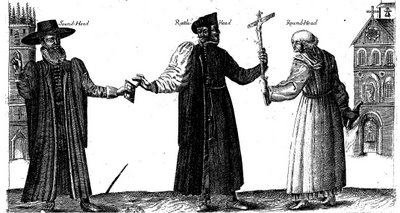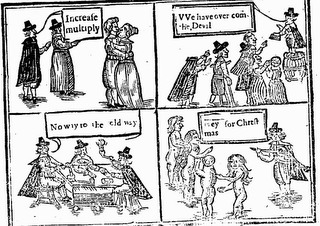The Roundhead's Reply?
Continuing with what has apparently become our "Roundhead Period," here's a great engraving (Thomason Tracts 669.f.6[94]) from the same year, 1642, as the ballad "My Bird is a Roundhead." This satirical print, however, strikes back at those who seek to marginalize the godly as out-of-the-mainstream "puritans" and "roundheads." Instead, the print asserts, those who hurl these epithets are themselves "athiests" and "Arminians," or even crypto-Catholics. The print shows three men: a Sound-head (left), a Rattle-head (center), and a Round-head (right): Beneath the Sound-head (who wears what seems to be a "puritan" hat but whose costume does not seem otherwise particularly "puritan") are these verses: This Foolish World is full of foule mistakes,According to ESTC, the Rattle-Head--so-called because his two-faced head rattles from one side to the other--depicts a composite of Robert Philips, the Queen's confessor, and Archbishop Laud. He is in the process of turning from the English to the Roman Church, taking the Bible from the godly Sound-Head in one hand and transforming it into the crucifix he gives the Round-Head with his other hand. Laud, the story goes, was offered a cardinal's hat by the Pope: his defenders pointed out that he refused it; to his critics, the point was that he was offered it. The verses beneath him read: See, heer, the Rattle-Heads most Rotten-Heart,Finally, the Round-Head image shows the godly appropriation of the pejorative epithet, turning it back on anti-puritans, who are revealed as Catholic sympathizers, if not Catholics themselves: But heer's a Round-Head to the purpose shown,The engraving, combined with the ballad discussed earlier, nicely shows how the idea of orthodoxy itself became a battleground, with each side claiming to represent the mainstream of English Protestantism. And it shows how the battle was waged in the popular press, through images and through poetry. Notes:
|



At 4/30/2006 10:10:00 PM, Simplicius wrote…
Simplicius wrote…
Another great post. I love the Rattle-Heads. And note the Round-Head's hat: how does that compare to the hat of our famous owl-owning taunter of Puritans? We shouldn't expect the same degree of precision in a ballad woodcut, but it appears that guy's hat may be a simple non-denominational rustic hat. Stick a feather in it and it'd look like those farmer hats you can buy in the Austrian alps (as apparently the members of the Chattanooga girls' choir discovered).
Also, the above engraving is on the cover of one of my favorite all-time academic books, Anthony Milton's Catholic and Reformed. Such a smart book.
At 4/30/2006 11:34:00 PM, Hieronimo wrote…
Hieronimo wrote…
Anthony Milton's Catholic and Reformed. Such a smart book.
 They're "Ranters," not "puritans," but I'm not sure that, in a 1650 popular print, we should imagine much difference between the two terms. All their hats are much closer to the Sound-Head's hat than to the owl-man's.
They're "Ranters," not "puritans," but I'm not sure that, in a 1650 popular print, we should imagine much difference between the two terms. All their hats are much closer to the Sound-Head's hat than to the owl-man's.
A great book indeed.
On the hat question, I think probably the ballad owl-man's hat is a nondescript country hat, to go with his nondescript doublet and breeches. When publishers wanted to depict puritans in a woodcut, they seem to have done so with the more square-topped hat familiar to those of us who grew up in the U.S. from countless Thanksgiving pageants--here's an image from The Ranters Declaration (1650, Wing S6087):
I'm having some bad flashbacks to third-grade school plays.
At 5/01/2006 12:08:00 AM, Inkhorn wrote…
Inkhorn wrote…
That's a great cut, the Sound-head thing. Not to diminish the importance of hats, but what do we make of the two churches in the background? The one on the right has some obvious features -- statuary; a bell; a rather prominent cross, which I guess we can associate with the crucifix. But several things strike me as rather odd. First of all: the door here is open, while the door in the other church is closed. The Catholic church seduces everyone, it creates space for everyone, while the true church is open only to the elect -- only to those who are, so to speak, already inside? It doesn't really need a door at all. But I'm surprised that it's such a cathedral-looking construction: it doesn't look low-church at all. Is there something about the particular architecture here that's supposed to be conveying some meaning that I'm not getting?
At 5/01/2006 12:24:00 AM, Hieronimo wrote…
Hieronimo wrote…
The statue is, I think, a madonna and child (this is easier to see on EEBO where you can blow up the image much more).
But the rose window at the top of the facade is pretty similar to the rose window on the west facade of Old St Paul's, so I'm not sure we should make too much of the more minor details. The madonna and child is rather obvious, but some architectural features may just signifiy "church," without any particular ideological spin. Unless of course the engraver is associating Old St Paul's with Rome.
My original thought when I saw the print was that the Sound-Head's church was meant to represent St Paul's, since the print is trying to lay claim to the mainstream of the English church--but actually, I'm not sure how much it resembles Old St Paul's (images from Dugdale available here).
All of which is to say, I don't know. But the Sound-Head's church doesn't strike me as that ornamental--no large (stained-glass?) windows like the Round-Head's; no rose window; no statuary, etc. I'm guessing it's supposed to represent your basic large English church--St Paul's or Salisbury or something like them.
At 5/01/2006 12:25:00 AM, Hieronimo wrote…
Hieronimo wrote…
Not to diminish the importance of hats ...
That should be our new blog description line.
At 5/01/2006 12:38:00 AM, Inkhorn wrote…
Inkhorn wrote…
I think that's right. It's probably *not* some kind of puritan tabernacle precisely to suggest that *this is* in fact where the mainstream of the English church has been and should continue to be, against the Arminians who would secretly hand everything back to the pope. So it's against the beauty of holiness, but without pushing the iconoclastic envelope too far. This may tell us something about Sound-Head's outfit, too -- simple, but not excessively coded "puritan."
Sound-Head's church doesn't look much like old Paul's, but it looks oddly familiar to me -- that square tower, almost no windows, with a kind of enclosed Englishness to it. The more I look at the other church, the more it almost begins to look baroque by comparison.
I think we can read stuff into these kinds of details -- this is clearly an image produced for this specific text, and someone has been thinking, here.
At 5/01/2006 09:23:00 AM, Simplicius wrote…
Simplicius wrote…
I like your take on the open door of the Catholic church, Inkhorn. But while we're talking about the iconography of this image, why do we think that Sound-Head is pointing up with his right hand and Round-Head is holding some sort of scroll with his left? Besides the suggestion that he's pointing up to God, Sound-Head's hand, I think, also marks him as the de facto speaker of the lines below the image. But Round-Head's scroll? (It is a scroll, right?) I'm blanking on what that might signify.
At 5/01/2006 12:04:00 PM, Hieronimo wrote…
Hieronimo wrote…
(For some reason, I'm unable to upload the image to Blogger right now--if it starts working later, I'll edit this out and replace it with the image, but trust me, it looks just like the one Sound-Head is making).So I assume this indicates Sound-Head as a wise man to be listened to.As for the scroll, my guess would be that it's meant to suggest a Papal bull, perhaps Regnans in Excelsis (1570) ...
At 5/01/2006 12:40:00 PM, Simplicius wrote…
Simplicius wrote…
Cool--I didn't know the name for that gesture. I'll be sure to start using the attentionem poscit gesture in class, and calling it that, so that I can wow the students with another fancy term.
Yeah, I thought about a papal bull or dispensation of some sort. I don't normally think of the early modern Catholic Church as being stereotypically represented as the Church of Paperwork, but I'm hard pressed to come up with an alternative interpretation of the scroll.
At 5/01/2006 12:52:00 PM, Hieronimo wrote…
Hieronimo wrote…
Well, Regnans in Excelsis was pretty notorious (it's the one that excommunicated Elizabeth and granted merit to anyone who assassinated her). Came to stand for the Pope's deposing power. Just a guess...
At 5/01/2006 02:28:00 PM, Inkhorn wrote…
Inkhorn wrote…
I think it's in opposition to the bible that Sound-Head gives Rattle-Head: not the word of God, but -- and here I think Hieronimo's right -- the word of the pope. Note where the scroll is being held: it's just beside the door of the church. This is a text that pertains to the institution, that's coming from the institution. It's common in Protestant polemical images that I've seen to represent the Decretals, in particular, as a kind of false Bible, a fallen and merely human text, as opposed to the inspired word of God. I haven't seen this depicted before as the difference between a scroll and a book, which is interesting. Might proclamations and such be given out in formats like this? Maybe it's not a scroll, per se, but a kind of fancy, official broadside? What would "Regnans in excelsis" actually look like? That's an interesting question.
Scribble some marginalia
<< Main